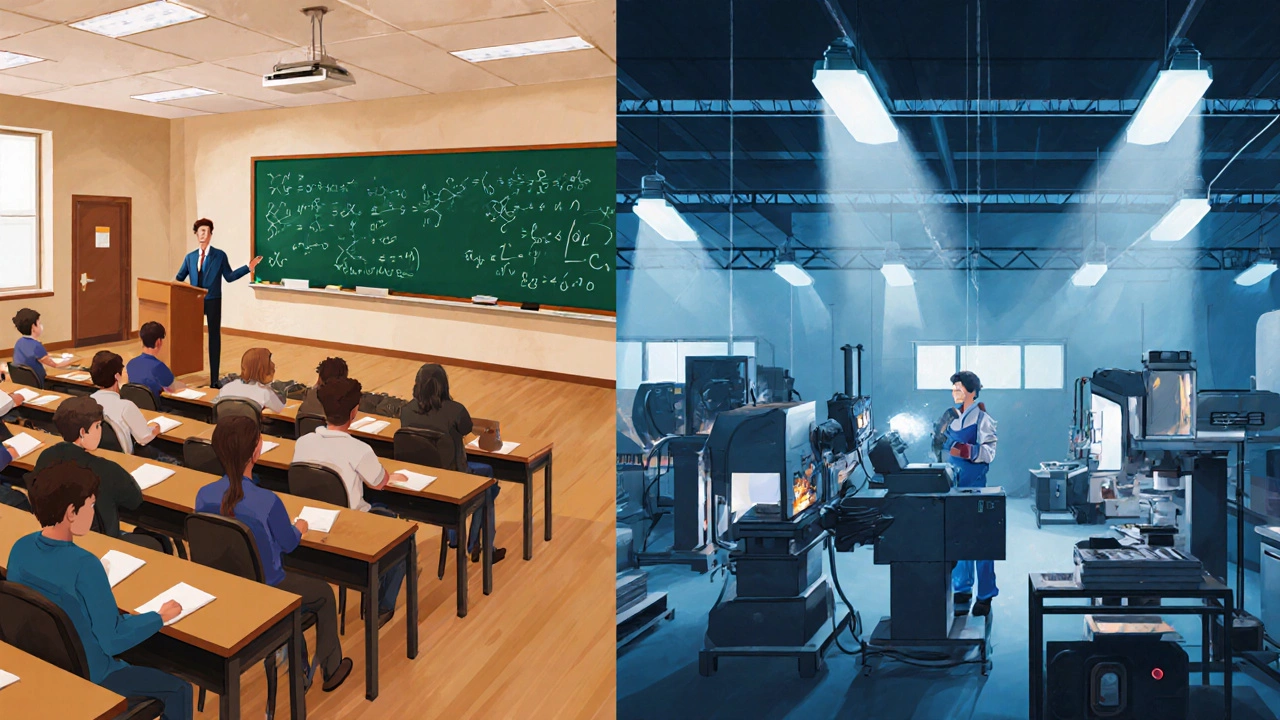College vs Vocational Training Cost Calculator
Calculate Your Financial Path
Compare the total costs and potential earnings between college and vocational training to make an informed decision.
Break-even Timeline
Time until vocational earnings match college earnings
Based on your inputs, vocational training becomes financially advantageous after approximately years.
Key Insights
Choosing between a four‑year university and a hands‑on trade program can feel like stepping into a maze. One path promises a broad academic experience, the other a direct ticket to a specific job. This guide cuts through the hype, spelling out the real differences so you can pick the route that matches your goals.
Quick Takeaways
- College typically offers a four‑year degree with a mix of theory and electives; vocational training focuses on practical skills for a single profession.
- Costs differ dramatically - university tuition can be several times higher than trade‑school fees.
- Time to finish ranges from 2‑4 years for vocational certificates up to 3‑5 years for a bachelor’s.
- Employers value both, but the weighting depends on the industry and role.
- Both routes can lead to further study; many trade schools offer credit transfers to colleges.
Defining the Two Paths
College is a post‑secondary institution that awards academic degrees-typically associate, bachelor, master, or doctorate-across a wide range of subjects. Students spend most of their time in lectures, labs, and seminars, building a foundation of critical thinking, research skills, and a broad knowledge base.
Vocational training is a career‑focused education system that prepares learners for specific trades or occupations through hands‑on instruction, apprenticeships, and industry‑certified coursework. It emphasizes practical ability over theory and often partners directly with employers.
Duration and Credential Types
College programs are usually measured in academic years:
- Associate degree - 2 years, often used as a stepping stone to a bachelor’s.
- Bachelor’s degree - 3‑4 years, the most common entry‑level qualification for many professions.
- Master’s and doctorates - additional 1‑4 years for advanced specialisation.
Vocational routes compress training:
- Certificate - 6‑12 months, targeting core job skills.
- Diploma - 1‑2 years, deeper coverage for roles like plumbing or graphic design.
- Apprenticeship - blends part‑time work with classroom instruction, typically 2‑4 years, culminating in an industry‑recognized qualification.
Cost Comparison
Money is a major factor. In the UK, the average tuition for a three‑year bachelor's degree at a public university sits around £9,250 per year for domestic students, not counting living expenses. By contrast, a full‑time vocational diploma can cost between £3,000 and £7,000 for the entire program, and many apprenticeships are funded by employers.
Student loans for college are widely available but can leave graduates with debt upwards of £30,000. Vocational students often qualify for government subsidies, grants, or even a paid placement, dramatically reducing out‑of‑pocket costs.

Learning Environment and Teaching Style
College classrooms favour lectures, seminars, and assessments like essays and exams. Critical thinking, research projects, and group work shape the experience. Technical college is a hybrid institution that blends academic study with applied labs, often bridging the gap between traditional college and trade schools. still leans toward theory.
Vocational training shifts the focus to labs, workshops, and real‑world projects. Instructors are often industry professionals, and the curriculum is updated quickly to mirror current workplace tools. Students spend a lot of time on the job-whether it’s wiring a house, coding a website, or operating CNC machines.
Career Outcomes and Job Market
Employers look for different things. A college graduate might be hired for a role that requires analytical reasoning, project management, or a degree‑specific credential-think accountant, marketing analyst, or software engineer.
A vocational graduate, on the other hand, is ready to perform a specific task from day one. Employers in construction, automotive repair, culinary arts, or health‑care support staff often prefer candidates with a recognised certificate or apprenticeship.
Data from the UK Office for National Statistics (2024) shows that the average starting salary for a bachelor’s graduate is £27,000, while a qualified electrician or dental hygienist-both typical vocational outcomes-starts around £24,000 to £26,000. However, vocational roles often see faster salary growth after the first 2‑3 years due to high demand and skill shortages.
Flexibility and Lifelong Learning
College degrees open doors to postgraduate study-a master’s or PhD-and to careers that require advanced qualifications, such as law or academia.
Vocational pathways aren’t a dead‑end. Many institutions offer stackable credentials, letting you start with a certificate and later add a diploma or associate degree. Professional bodies also provide Industry certification recognises mastery of specific tools or standards, such as CompTIA for IT or NVQ for UK trade skills. These can be earned while you work, keeping your skills current.
Pros and Cons at a Glance
| Aspect | College | Vocational Training |
|---|---|---|
| Time to Complete | 3‑4 years (bachelor) | 6 months‑2 years (certificate/diploma) or 2‑4 years (apprenticeship) |
| Cost (UK average) | £9,250 / year tuition + living costs | £3,000‑£7,000 total; many apprentices earn wages |
| Credential Type | Associate, Bachelor, Master, Doctorate | Certificate, Diploma, NVQ, Apprenticeship |
| Learning Style | Lectures, essays, labs, research projects | Hands‑on workshops, on‑the‑job training, industry mentors |
| Career Path | Broad, can shift sectors; often requires further study | Specific trade; immediate entry‑level employment |
| Salary Outlook (first 3 years) | ~£27,000 avg start | ~£24,000‑£26,000 start; faster growth in skilled trades |
| Flexibility for Change | High - transferable credits, graduate study | Moderate - stackable credentials, industry recertification |

How to Decide Which Path Fits You
- Identify your career goal. If you already know the job (e.g., plumber, chef), vocational training is usually faster and cheaper.
- Assess learning preferences. Do you thrive in classroom theory or in a workshop setting?
- Consider financial situation. Calculate tuition, potential earnings, and any available scholarships or apprenticeship wages.
- Research industry demand. Look at UK job market reports-skills like cybersecurity, renewable energy installation, and health‑care support are in high demand for vocational routes.
- Plan for the long term. If you might need a master’s later, a college foundation offers smoother progression.
Most people don’t need to pick one path forever. A growing trend is the “dual‑track” model: start with a vocational certificate, work for a couple of years, then pursue a part‑time degree to broaden prospects.
Common Misconceptions Debunked
- "Vocational training is only for low‑skill jobs." Modern trade schools teach advanced digital skills-think CNC programming, network engineering, or 3‑D animation.
- "College guarantees a better career." Many graduates struggle to find relevant work; unemployment rates for recent graduates can exceed 12% in some fields.
- "You can’t switch after choosing one." Credits from many vocational programs transfer to universities, and many colleges now offer short‑course certifications.
- "Apprenticeships are outdated." The UK government’s Apprenticeship Levy has modernised contracts, and apprentices now earn up to £30,000 in high‑skill sectors.
Real‑World Stories
Sarah, 24, London wanted a career in digital design. She enrolled in a one‑year graphic design diploma at a local college, worked part‑time at a design studio, and later transferred to a BA program. Today she freelances and earns more than the average graduate.
James, 19, Manchester loved engines. He joined an apprenticeship with a regional garage, earned an NVQ Level 3, and after two years was promoted to service manager, earning a salary 15% above the local average for mechanics.
These examples illustrate that the right choice depends on personal goals, not on a perceived hierarchy.
Next Steps: Mapping Your Own Path
- Explore local providers. Check the UK Register of Apprenticeship Training Providers (RoATP) for accredited courses.
- Calculate ROI. Use a simple spreadsheet: tuition + living costs vs projected salary over 5‑years.
- Talk to industry professionals. LinkedIn groups, local meet‑ups, or university career services can give insider insight.
- Apply for funding. Student loans, apprenticeship grants, or the Education and Skills Funding Agency (ESFA) bursaries can offset costs.
Remember, the best education route is the one that aligns with where you want to be in five years. Whether you pick a lecture hall or a workshop, keep learning, stay adaptable, and the career will follow.
Do I need a college degree to earn a good salary?
A high salary isn’t exclusive to college grads. Skilled trades like plumbing, electrical work, or cyber‑security certifications can command six‑figure earnings, especially with experience and certifications.
Can I transfer credits from a vocational diploma to a university?
Many UK universities accept vocational credits, especially from Level 3 diplomas or NVQs, as part of a “top‑up” degree. Always check the institution’s credit‑transfer policy.
What’s the typical age range for apprentices?
Apprenticeships are open to anyone 16 and older. It’s common to see participants from 18 up to 35, especially in sectors addressing skill shortages.
How does student loan debt compare between college and vocational routes?
College loans often exceed £30,000 for a full degree, while vocational loans or apprenticeships typically stay under £10,000, and many apprentices earn a wage that offsets repayments.
Is it possible to study part‑time while working a full‑time job?
Yes. Many vocational courses are offered evenings or weekends, and many universities now provide part‑time or online pathways that let you balance work and study.





Write a comment